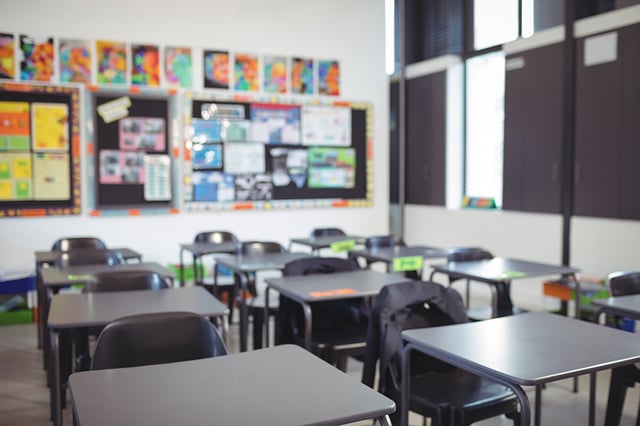How Districts Are Transitioning to Distance Learning
 Insights By Anna McVeigh-Murphy
Insights By Anna McVeigh-Murphy
Across the United States, nearly 50 million students are out of school. Some are joining classes remotely, others are completing take-home packets and workbooks, and many are out of school all together.
It’s an imperfect system, but educators and their communities are coming together to support and engage students in distance learning. Here is a look at some of the different strategies as this ‘new normal’ takes hold.
Education in a Pandemic
No matter how educators and their districts are approaching education in the time of a pandemic, the transition to distance learning is requiring a massive rethink of how students are taught and how instruction is delivered. One educator captured this sentiment well in explaining the monumental task of metamorphizing a centuries-old education system in a matter of weeks:
"Three days to create, print and distribute about 5 million pages of instructional content. Three days to load classes onto an online platform. Three days to gather online resources so aligned instruction could continue to take place. Three days to train about 8,000 teachers in a whole new way of work. Imagine that!
Three days to conduct a survey of technology needs from 130,000 students and to prepare thousands of computers for student use. Three days to prepare for neighborhood delivery of school lunches and snacks on our buses so children would not go hungry. Just three days to mobilize a community of partners and volunteers to assist our schools."
Because the systems for distance learning were often not in place prior to this year, the ability for schools to adopt this new approach varies.
In the examples we will share here, you will see instances of schools having to scale technology and broadband infrastructure to enable remote learning. Others are employing paper-and-pencil packets and activities as well as the good ol’ fashioned telephone. And when learning is delivered online, teachers are adopting both synchronous and asynchronous approaches to instruction.
1. How Are Districts Investing in Access and Connectivity?
Equitable access to online learning depends upon equitable access to computing devices and internet, otherwise known as the access and connectivity divide. While some school districts, like this one in Maine, are benefitting from expanded access and connectivity, as well as robust distance learning systems, from their snow day planning, others are having to develop integrated distribution plans to get these tools into the hands of students.
Distributing Computers
In order to manage the transition to online learning, schools are now rapidly deploying computing devices to students. These are a few examples.
- After previously cancelling online classes, Philadelphia schools are now ramping up efforts to distribute thousands of computers to students so they can access distance learning as the closures extend.*
- Similarly, New York City Schools have handed out 175000 computers to the roughly 300000 students without one in the district. They are planning to distribute more in the coming weeks.*
- In Maryland, Montgomery County Schools are distributing their in-class chromebooks to students without devices.
- In Texas, Arlington Independent School District is planning to distribute over 12000 digital devices.
- Similarly, the Erie County School District in New York is planning to distribute hundreds of chromebooks after the stay-at-home rules were extended. Previously, the district was offering optional online classes.
- Tempe Elementary School District and Scottsdale Unified School District in Arizona are also distributing laptops to connect students to distance learning.
*For both Philadelphia and New York City schools, they will be providing paper packets to supplement learning in the meantime.
Promoting Broadband Access
In addition to computing devices, schools are also working to enable wifi access for students and their families. For example, the school district in Fulton County, Georgia is quickly working to distribute hotspot devices to students without internet access.
Taking another approach, some districts are outfitting school buses with wifi and deploying them to where students can access them.
- South Carolina will deploy 3000 school buses outfitted with internet so that students can engage in online instruction.
- Similarly, in South Bend Indiana, students can access 20 school buses that propel internet 300 ft in all directions.
Other districts are also installing free public wifi on school buildings. For example, one Texas district installed stationary hotspots on buildings to which students can connect from their family cars.
2. How Are Districts Creating Unplugged Distance Learning Systems?
When widespread access and connectivity is not feasible, some districts are adopting unplugged alternatives to distance learning.
In some cases, these approaches involve the distribution of learning packets.
- In Ohio, Toeldo Public Schools are distributing learning packets. They developed a schedule for pick up in a drive thru.
- In South Dakota, a school district is embracing take-home packets to continue learning due to access and connectivity challenges. Families can either pick up and drop off worksheets or staff will deliver them. Once completed and submitted, the homework is kept isolated for 72 hours so any traces of the virus die.
- An Alaskan teacher in a school district the size of Indiana is using phone conferences to connect with students to coach them through their learning packets and workbooks.
Other unplugged distance learning alternatives are embracing television programming.
- For example, public schools in the District of Columbia are broadcasting teacher-led lessons on local television channels.
- In other large cities like Boston and Los Angeles, district leaders have also partnered with PBS stations to air educational programs for students.
3. How are Districts Structuring Online Learning?
Approaches to online learning are varied across the country.
Synchronous Approaches to Distance Learning
For some districts, they are looking to recreate the school day structure in a remote environment. For example, at Millcreek Township School District, students are required to complete daily lessons and assignments online. This is in addition to optional enrichment materials for continued learning.
Similarly, at a Georgia High School, teachers are working on transitioning to online learning in a way that keeps students engaged in a daily “class schedule.” In this approach, the teachers are paring down lesson from 55 to 30 minutes. Students can watch a video assignment and submit answers online or in writing via picture. The staff also plans to check in with students who are absent for more than three days to keep students engaged and active.
And a teacher in Illinois is hosting virtual class sessions via Zoom. While this has been challenging for some, Jaime Bazydlo was able to get 100% class participation.
Asynchronous Approaches to Distance Learning
Alternatively, at Friends’ Central School in Pennsylvania, teachers are taking an asynchronous approach to distance learning by providing students with resources and assignments they can do on their own time and at their own pace.
Other examples of asynchronous distance learning include:
- Derek Olson, a teacher at Memorial High School in Wisconsin, transformed his sunroom into a virtual classroom with a camera, tripod, and laptop provided by the district. He records and publishes the lessons on the school’s virtual platform in addition to other assignments his students can download.
- Kim Mattina, a middle school technology teacher in New Jersey, develops digital worksheets for students using apps like Screencastify, Jamboard, and Google Classroom to recreate the learning experience virtually and support students as they engage with content online.
- Thomas Courtney, a teacher in San Diego, records and publishes lessons via YouTube and Facebook as well schedules multiple conference calls a week with each kid in his class.
- Similarly, a physical education teacher in Brooklyn shares videos in which students can participate on their own time.
- Jacqueline Rhoads, a high school English teacher in New Jersey, sent students home with a learning contract to establish expectations for online learning. This includes office hours, study materials, learning objectives, curriculum, and an assignment checklist, as well as the dates and times of optional zoom meetings.

Derek Olson in his ‘new’ calculus classroom

Kim Mattina’s interactive digital worksheets
4. How Else Are Educators Engaging With Students?
Beyond the above approaches to distance learning, educators are also turning to social media to engage with their students and promote skills like literacy.
Nathan Sailor, an Ohio teacher, recorded himself reading amongst his cows, who were seemingly loving the story! Another teacher from the same district put on a virtual puppet show for students.


Photo Credit: sidneydailynews.com
And in Illinois, Kelly Kohrt, an elementary school teacher, recorded and shared herself reading ‘Llama Lama Red Pajama’ for students and was joined by her bulldog, Lola.

Photo Credit: theherald-news.com
Final Thoughts
How do you keep the feelings of learning, spirit, and community up in a time when students cannot attend school, at least in the traditional sense? There is no singular approach, but the educators and their district teams featured here show that it is possible. As we settle into this new, albeit temporary, normal, education is having to reinvent itself to keep students engaged and supported. There will no doubt be more and similarly creative approaches to this unprecedented challenge.






